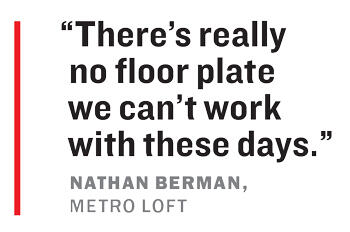In one of the great ironies of the pandemic, there is too much office space and not enough housing, yet no scalable way to turn workplaces into homes.
So says Moody’s Analytics, at least. It found just 3 percent of New York offices fit the bill for conversion.
The rest are too big, too pricey and too expensive to finance. And that’s without accounting for the headache of zoning.
Manhattan’s office vacancy rate hovers around 16 percent. In the Financial District and on Third Avenue in Midtown East, about a quarter is empty.
The estimate pours cold water on the Real Estate Board of New York’s projection that converting just 10 percent of the 210 million square feet of older, crummier office space could create 14,000 apartments — a down payment on the 560,000 New York needs by 2030 to catch up with population growth.
However, Nathan Berman, the developer who transformed Lower Manhattan’s commercial excess into thousands of residential units, said if asking prices for office towers drop another 10 to 15 percent, it would open up a host of opportunities to firms less experienced in conversions.
But to his veteran eyes, the market is already ripe.
“If you know what you’re doing,” he said, “prices are low enough to undertake conversions.”
Berman’s Metro Loft Developers has spearheaded 20 office-to-residential projects over its 25-year run. He is teaming with Silverstein Properties to convert 55 Broad Street and with GFP Real Estate and Rockwood Capital to reshape 25 Water Street. The latter would be the city’s largest residential conversion, at 1,200 units.
“In the late 1990s, he’s the guy who seems to have figured this all out,” said Carol Willis, founder of the Skyscraper Museum. She debuted an exhibit this summer detailing how Berman seized on cheap, vacant offices and government incentives to reimagine the Financial District.
“I’m making a case that Downtown is a model for post-Covid Midtown,” Willis said.
Size doesn’t (really) matter
Most developers say a successful conversion hinges on a building’s structure. If the bones are too big, residential layouts don’t make sense, given the city’s requirements for natural light, including a window in every bedroom.
Moody’s pegged the ideal floor plate for conversion at 14,000 square feet, which can be carved into 1,000-square-foot apartments, plus 400 square feet for an elevator.
Silverstein liked 55 Broad Street because the floors hit that sweet spot: 10,000 to 15,000 square feet.
 “If we were creating this building from scratch, this is how we would have done it,” Silverstein CEO Marty Burger said.
“If we were creating this building from scratch, this is how we would have done it,” Silverstein CEO Marty Burger said.
In New York, such buildings hail from two eras.
Towers built in the 1920s and 1930s offer the shallow window-to-core depth that’s great for residential, according to architecture firm Gensler’s Steven Paynter, who helped create an algorithm to identify buildings ripe for conversion.
Developments from the 1960s and early 1970s are similarly skinny; 55 Broad, for example, was built for Goldman Sachs in 1967.
“Downtown was the first office market in New York City, so there’s a prominence of older buildings,” Burger said. “There’s probably more opportunity to do conversions in the Downtown market than there is in Midtown.”
Midtown is chock full of 1970s and 1980s construction, steel-framed giants with “a big floor plate that makes conversions challenging,” according to Jeffrey Havsy, who leads Moody’s commercial real estate industry practice.
But of the Lower Manhattan conversions Willis studied, many were in larger buildings — “the kind people say don’t work,” she said.
Berman was behind a number of them. He contends that behemoths demand creative layouts, but size is not a deal breaker. The key is repurposing a building’s center.
“There’s really no floor plate we can’t work with these days,” Berman said.
Some opt to core it. Vanbarton Group, working with Metro Loft to convert the 1970s-era 180 Water Street in 2015, cut a 30-by-40-foot hole down its center, said Joey Chilelli, an executive at Vanbarton.
To convert its neighbor, 500,000-
square-foot 160 Water Street, into 588 apartments, Chilelli said Vanbarton will create three smaller voids.
Others have turned interiors into amenity space, which doesn’t require windows. Gensler cited PMC Property’s conversion of One Franklin Plaza in Philadelphia as an example.
Penciling out
Carving out sections of buildings, though, can get expensive. For a developer to pursue such a project, it must start with a discounted property.
FiDi buildings at the turn of the millennium were prime candidates because they were cheap. Tax breaks passed in the early 1980s to encourage commercial projects gave rise to a glut of offices, setting up big valuation declines after the 1987 stock market crash and 9/11.
Berman recalls towers selling for $30 to $40 per foot or cheaper. “The price per pound was very, very attractive,” he said.
The pandemic has yet to produce the same discounts. Manhattan office sale prices actually rose from about $400 per square foot in the second quarter of 2021 to over $800 per square foot in the first quarter of 2022, Avison Young found.
Rising interest rates have since pushed the number down to $689. But for a conversion to pencil out, Moody’s calculated, an office tower would need to sell for $262 per square foot or less. Only 20 percent of U.S. office sales were at or below that threshold last year.
The landlord problem
Deeper discounts likely depend on an acceptance among office owners that tenants won’t maintain their pre-Covid footprints.
Many landlords are holding out hope.
A poll of 170 CBRE clients found that about half believed office attendance, which has stalled at around 47 percent, would improve, said CBRE’s head of U.S. office research, Jessica Morin.
“Owners are going through various stages of grief,” said Hines’ Dusty Harris, who is leading the firm’s conversion of South Temple Tower in Salt Lake City.
Read more


Vanbarton’s Chilelli agreed. “We’re not quite there yet in terms of owners and what they believe the values of their buildings to be that might be 100 percent vacant right now,” he said.
But Berman, in contrast to Moody’s April report, said he’s beginning to see attractive discounts in New York. Most are Downtown, which helps explain the FiDi conversions.
Owners are going through various stages of grief.
“But that’s changing as B-minus office buildings in Midtown are hurting and prices are coming down,” Berman said. “And a lot of these prices that are down are still soft prices. There’s room to negotiate.”
Metro Loft is pondering several conversion opportunities there, Berman said.
Newmark predicted that nationally, the combination of rising rates and a large number of office loans coming due in the next two years could create more distress and thus conversion candidates.
Higher interest rates are a double-edged sword for developers, however, as they make construction loans more expensive. If short-term rates remain high, some figure to pause or delay projects.
Silverstein, for one, asked for more time to close on 55 Broad Street. Burger downplayed the extension, noting that the firm has kept to the $180 million purchase price and expects to close in the new year.
Glass half full
Despite the macroeconomic headwinds, Berman still foresees low-hanging fruit.
“As it is, these assets are trading at essentially the price of the land they’re sitting on,” he said, meaning a developer would need to keep conversion costs below those of a ground-up development for it to make sense.
That’s the math behind 55 Broad Street. Silverstein and Metro Loft agreed to buy the building from Rudin Management for about $423 per square foot. By comparison, development sites traded at an average of $532 per buildable square foot in the third quarter, Avison Young found.
Berman said the conversion would cost one-third of the price of new construction. Given what people are paying to live in luxury units Downtown, the project pencils out.
“We’re getting rents that are close to what a new building would get, but we’re not paying the new-building price,” said Silverstein’s Burger.

Most developers pursuing conversions are creating high-end apartments, which have continued to attract record-high rents as prices for lesser units have flatlined.
It’s possible that rents could drop, given the threat of recession. But developers are adamant that declining pricing power is not among their fears.
“New York City has always been a market that is short on housing,” Burger said.
The missing piece
If FiDi’s distress in the 1980s and 2000s planted the seeds for conversions, government incentives offered the sun and water.
“There was this package of opportunities that incentivized them,” Willis said.
In 1995, the city introduced 421g, a decade-long tax abatement for conversions. A zoning tweak allowed residential retrofits of Lower Manhattan buildings built before 1977. Previously, the date had been 1961.
Post-9/11 Liberty Bonds padded the financing for conversions.
But nearly three years into the pandemic, New York has yet to introduce similar incentives.
Gov. Kathy Hochul early this year proposed a revision to the state’s multiple-dwelling law that aimed to enable more conversions. It would have allowed more flexibility on floor area, light and air requirements in residential redevelopment south of 60th street. But it didn’t go through.
Later, the City Council created a task force to study the adaptive reuse of office space. The group has spent six months evaluating the regulations for conversions and expects to make recommendations this month.
Dan Garodnick, director of the Department of City Planning, said the task force “has not yet landed on an answer to the question” of what incentives might work best.
The state’s failed attempt to fund hotel conversions offers a cautionary tale. A year into the pandemic, Albany allocated $100 million for such projects, but received only one application. Lawmakers did not appreciate the zoning, building codes and costs involved.
Hochul eased some regulations and allocated another $100 million to the program in this year’s budget, but so far only four proposals have come in from New York City developers, according to Politico.
The task force has considered ways to make zoning more inclusive. Garodnick said moving up the completion date for conversion-eligible buildings from 1961, as the city did in FiDi, has been tossed around.
“In many parts of Midtown, office buildings need to be over 61 years old,” Garodnick said. “That’s pretty restrictive.”
To update that law, the City Planning Commission would need to propose a zoning text amendment and the City Council would have to approve it.
Berman believes such a tweak could be what’s needed to turn conversions from a fringe endeavor into a citywide trend.
“Just change a single digit in the current zoning,” Berman said. “Make that 1961 cut-off a 1981 cut-off, and that will include probably 50 percent more buildings.”

